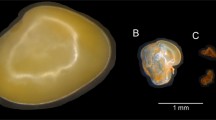Summary
-
1.
Pods set in both types of crosses (2n C.G.×4n C.G. and 4n C.G.×2n C.G.). Five pods are found to reach up to maturity in case of 2n C.G.×4n C.G. Pods set in case of the second cross shed within a week.
-
2.
In 2n D 154×4n D 154 and its reciprocal crosses no pod sets at all.
-
3.
The cross pods (2n C.G.×4n C.G.) are shorter than those of both parents.
-
4.
In 2n C.G.×4n C.G. and its reciprocals, the egg is found to be fertilized within 24 hours. But in 2n D 154×4n D 154 and its reciprocals, pollen tube does not reach the ovule in one day.
-
5.
Complete fusion of the egg and the sperm in case of 2n C.G.×4n C.G. and its reciprocals is not observed even in two days. But in case of 2n D 154×4n D154 and its reciprocals no fertilization is observed.
-
6.
Degeneration of ovules starts on the 3rd day in case of 4n C.G.×2n C.G. In 2n D 154×4n D 154 degeneration starts on the 2nd day and in its reciprocal degenerating ovules are marked on the 3rd day.
Similar content being viewed by others
References
Brink, R. A. andD. C. Cooper—1941. Incomplete seed failure as a result of somatoplastic sterility. Genetics, 26: 487–505.
——1947. The endosperm in seed development. Bot. Rev. 13: 423–541.
——1947. Effect of the De17 allele on development of the maize caryopsis. Genetics, 32: 350–368.
Buchholz, J. T. andA. F. Blakeslee—1929. Pollen tube growth in crosses between balanced chromosal types ofDatura stramonium. Genetics 14: 538–568.
Chui, T. C.—1942. Cytology of the autotetraploid rye. Bot. Gaz. 104: 627–632.
Cooper, D. C. andR. A. Brink—1940. Somatoplastic sterility as a cause of seed failure after interspecific hybridization. Genetics, 25: 593–617.
——1945. Seed collapse in following matings between diploid and tetraploid races ofLycopersicum pimpenillifolium. Genetics, 30: 367–401.
Cooper, D. C.—1951. Caryopsis development following matings between diploid and tetraploidZea mays. Amer. J. Bot., 38: 702–708.
Cua, L. D. —1952. Artificial polyploidy in theOryzae. IV. A tetraploid hybrid from the cross ‘diploid×tetraploid’ in rice,Oryza sativa Linn. Cytol., 17: 183–190.
Fagerlind, F.—1944. Kompatibilität und Inkompatibilität in der GattungRosa. Acta Horti Bergiani, 13: 247–302.
Ganessan, A. T., S. S. Shan andM. S. Swaminathan—1957. Cause for the failure of seed setting in the crossC. olitorius×C. capsularis. Curr. Sci., 26: 292–293.
Håkansson, A.—1952. Seed development after 2n, 4n crosses inGaleopsis pubescens. Hereditas, 38: 425–448.
Johnsson, H. — 1945. The triploid progeny of the cross diploid x tetraploidPopulus tremula. Hereditas, 31:
J¢rgensen, C. A.—1928. The experimental formation of tetraploid plants in thegenus Solanum. J. Genet., 19: 133–210.
Julen, U.—1950. Fertility of tetraploid red clover. I. Seed setting of tetraploid red clover in the presence of haploid pollen. Hereditas, 36: 151–160.
Kostoff, D. andI. Kendall—1934. Studies in polyploid plants. III. Cytogenetics of tetraploid tomatos. Gartenbauwiss. 9: 20–44.
Levan, A.—1948. Polyploidy in flax, sugarbeet and timothy. Proc. 8th Int. Genet. Cong. 46–47.
Lowe, J. andO. E. Nelson, Jr.—1946. Miniature seed—a study on the development of a defective caryopsis in maize. Genetics, 31: 525–533.
Lindstrom, E. andL. M. Humphrey—1933. Comparative investigations of a haploid tomato and its diploid and tetraploid progeny. Amer. J. Bot. 18: 398–410.
Mangelsdorf, P. C.—1926. The genetics and morphology of some endosperm character in maize. Connecticut Agrl. Expt. Sta. Bull. 279: 573–614.
— andR. G. Reeves—1931. Hybridization of maize, Tripsacum and Euchlaena, Jour, Hered. 22: 329–343.
Morinaga, T. andE. Kuriyama—1951. Triploid rice obtained from the cross 2n×4n (Japanese). Abs communicated in the 1 st Ann. meeting. Jap. Soc. of Breeding.
Müntzing, A. 1930a. Outlines to a genetic monograph of the genus Galeopsis. Hereditas, 12: 185–341.
—. 1930b. Ueber Chromosomenvermehrung in Galeopsis—Krenzungen und ihre phylogenetische Bedeutung. Hereditas, 14: 153–172.
—. 1935. The evolutionary significance of autoploidy. Hereditas 21: 263–378.
—. 1941. New material and cross combinations in Galeopsis after colchicine induced chromosome doubling. Hereditas, 27: 193–201.
Nilsson, E.—1950. Some experiments with tetraploid tomatoes. Hereditas 36: 181–204.
Nshiyama, I.—1951. (In Japanese) On the occurrence of unexpected 4n hybrids from the crosses 2n×4n inBrassica. Abs. communicated in the 23rd Ann. meeting of Genet. Soc. of Japan. Jap. Jr. of Genet. 26: 234.
Pandey, K. K.—1955. Seed development in diploid, tetraploid and diploid x tetraploid ofTrifolium pratense L. Ind. J. Genet. & Pl. Br. 15 (I): 25–35. 1956. Studies in autotetraploids of Linseed (Linum usitatissimum L.) II.
Pandey, K. K. Morphology and cytogenetics. Lloydia 19(4): 245–259.
Patel G. I. andDatta, R. M. (in press). Investigations on the autotetraploids of the cultivated and the wild types of jute (C. olitorius x C. capsularis) and on the 2n×4n population of cultivatedolitorius.
Ramanujam, S. andM. J. Desmukh—1945. Colchicine induced polyploidy in crop plants. III. Brassicae. Int. Jour. Genet. & Pl. Br. 5: 63–81. References with asterisks not consulted in original.
Randolph, L. F.—1935. Cytogenetics of tetraploid maize. Jour. Ag. Res. 50: 591–605.
Rasmusson, J.—1948. Olika kromosomtals in verkan pa sockerbetornas egenskapen. Nordisk Jordbrugs forsking 1948: 1–3 h.
Renner, O.—1939. Kurze Mittelungen über Oenothera III. Ubergigas undSemigigas formen und ihre Verwendung zur untersuchung des cruciata-Merkmals. Flora, n.f. 33: 215–238.
Sansome, E. R., S. Satina andA. F. Blakeslee 1942a. Disintegration of ovules in tetraploid-diploid and incompatible species crosses in Datura. Bull. Torrey Bot. 69: 405–420.
——1942b. Crossability between species and between tetraploids and diploids inDatura. Genetics, 27: 168.
Shibata, K.—1957. On the relationship between the results of reciprocal crosses of 4n×2n and their oppositional genotypes in Brassica pekinensis Rupr. Jour. Ag. Sc. Tokyo. 3(3): 273–280.
Upcott, M.—1935. The cytology of triploid and tetraploidLycopersicum esculentum. Jour. Genet. 31: 1–99.
Watkins, A. E.—1932. Hybrid sterility and incompatibility. Jour. Genet. 25: 125–162.
Author information
Authors and Affiliations
Rights and permissions
About this article
Cite this article
Datta, R.M., Banerji, S.N. On the cause of seed failure or seed setting in 4n cultivatedcorchorus capsularis L.×2n cultivatedC. capsularis and 4n cultivatedC. olitorius L. ×2n cultivatedC. olitorius and their reciprocals through cytogenetical studies. Genetica 31, 385–409 (1960). https://doi.org/10.1007/BF01984437
Issue Date:
DOI: https://doi.org/10.1007/BF01984437




